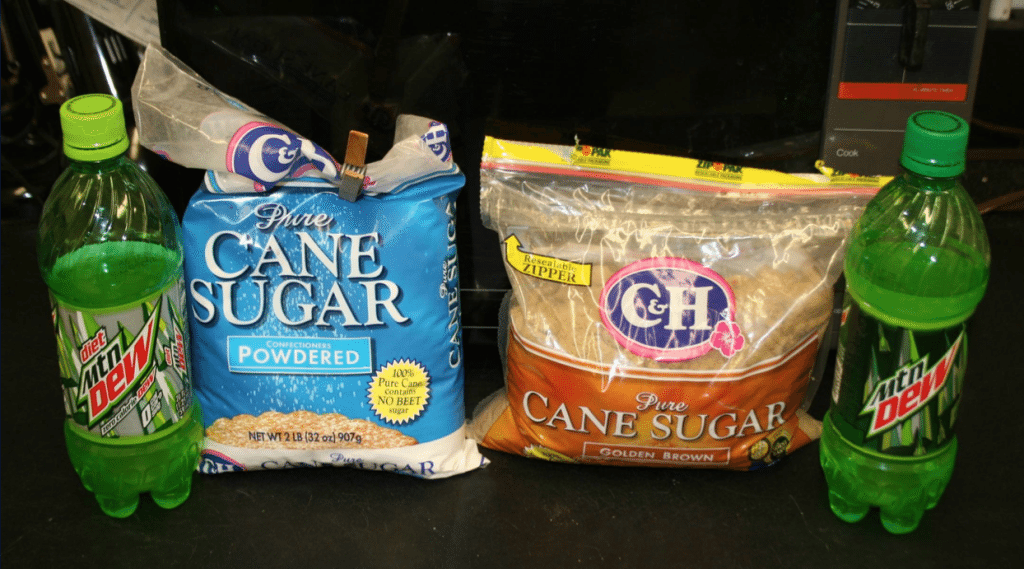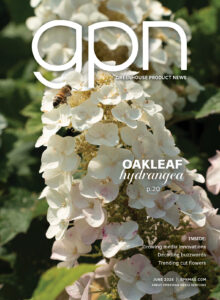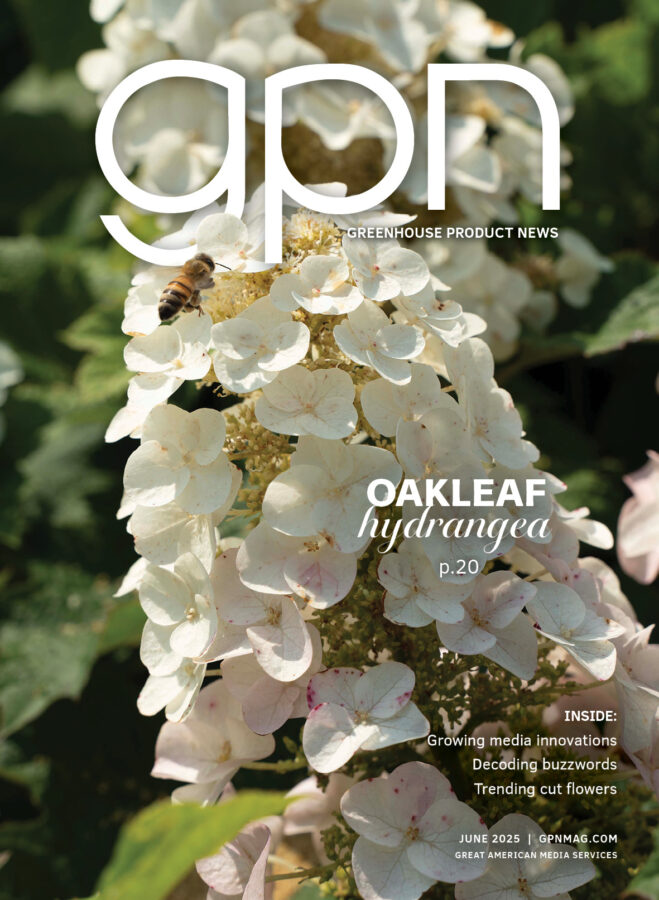
Enhancing Insecticides with Sugar-Based Compounds
Western flower thrips (Frankliniella occidentalis) is the most destructive insect pest of greenhouses worldwide causing both direct and indirect damage to a wide range of horticultural crops. The primary means of dealing with these pests in greenhouse production systems is the use of insecticides. However, greenhouse producers are continually seeking alternative options to manage Western flower thrips in order to alleviate the prospect of resistance and thus preserve already existing commercially-available insecticides. Furthermore, it is difficult to suppress Western flower thrips due to their "thigmotactic behavior," which means that the body is in constant contact with a surface so they tend to occupy narrow crevices in plant parts. So they tend to reside in tight-enclosed areas including unopened flower buds and terminal buds, decreasing their susceptibility to insecticide sprays. There has been interest in utilizing materials that lure or attract Western flower thrips to increase the efficacy of insecticide spray applications (attract-and-kill strategy).
It has been commonly believed that the addition of sugar to an insecticide may enhance the efficacy of the insecticide in controlling Western flower thrips. However, there has been no scientific information to support this notion. In fact, a recommendation provided in the 1940s was to use sugar as a feeding stimulant for controlling Western flower thrips. This supposedly involved adding white sugar with a stomach poison insecticide to enhance the efficacy of the spray solution. In fact, greenhouse producers continually ask or suggest that mixing sugar such as white powdered or brown sugar, or a sugar-laden soft drink (e.g., Mountain Dew) with a contact insecticide (in a spray solution) enhances the efficacy of the spray application against Western flower thrips. It has also been suggested that molasses and brown sugar will act as a surfactant or attract thrips from flowers and encourage them to consume or come in contact with insecticide residues.
White sugar is pure sucrose derived from either tropical sugar cane or sugar beets. In contrast, there are two types of brown sugar: sticky and free-flowing. Both types are obtained by adding syrup, such as molasses, to purified or refined sugar. Mountain Dew, which is a sugar-laden soft drink, contains 31 grams (in 8 ounces) to 77 grams (per bottle) of sugar as high-fructose corn syrup. As such, it is difficult to understand how and why a plant-feeding insect, which feeds primarily on pollen and plant tissue, would be attracted to any type of sugar, particularly if the sugar doesn't provide any essential nutrients (proteins and amino acids) required for development and reproduction. There are no studies that have actually substantiated claims made regarding using sugar or sugar-based compounds with contact insecticides to enhance efficacy against Western flower thrips. Therefore, the objective of this study was to determine if sugar-based compounds are attractive to and improve control of Western flower thrips when mixed with insecticides under greenhouse conditions.
Materials and Methods
The compound treatments were white powdered sugar (C & H Sugar Company; Crockett, Calif.), brown sugar (C & H Sugar Company; Crockett, Calif.), Mountain Dew (PepsiCo Inc., Deep Gap, N.C.), Diet Mountain Dew (PepsiCo Inc., Deep Gap, N.C.) and a water control. The initial rates included 0.12 g/100 mL of white powdered sugar, 0.12 g/100 mL of brown sugar, 0.18 mL/100 mL of Mountain Dew, and 0.18 mL/100 mL of Diet Mountain Dew. These rates were used based on inquiries and feedback from greenhouse producers. We also used higher (two-fold) rates: 0.24 g/100 mL of white powdered sugar, 0.24 g/100 mL of brown sugar, 0.36 mL/100 mL of Mountain Dew, and 0.36 mL/100 mL of Diet Mountain Dew.
All experiments were conducted in a glass-covered greenhouse, and the procedures were similar for the four experiments. Yellow cut transvaal daisy, Gerbera jamesonii flowers were obtained from a wholesale broker (Koehler & Dramm of Missouri; Kansas City, Mo.). No pesticides had been applied to the cut flowers before harvest from the broker, so the possibility of any pesticide residues negatively affecting Western flower thrips' survival was minimal. Flower stems were excised 5.1 to 7.6 centimeters below the base of the flowers and placed into 22-millimeter low background borosilicate glass vials containing tap water. One transvaal daisy cut flower was placed into each glass vial. The glass vials were inserted into plastic containers (250-mL) with sand, which held the glass vial containing the tap water and the cut flower upright during the experiments. One container or cut flower was equal to one experimental unit.
All the plastic containers, with the cut flowers, were positioned in a polyvinyl chloride (PVC) pipe open frame on a wire-mesh bench and the designated treatment containers, with the cut flowers, arranged in a completely randomized design. A 50 percent black knit shade cloth was positioned over the PVC frame to protect the cut flowers from direct sunlight and thus preserve their longevity. Each cut flower was artificially infested with approximately 15 to 20 Western flower thrips (90 percent adults and 10 percent nymphs) obtained from a laboratory-reared colony.
All flowers were sprayed with the appropriate treatments using a 946-mL plastic spray bottle two days after post-infestation. Each flower was sprayed to runoff with approximately 15.0 mL of spray solution. This spray volume thoroughly saturated the flower surface and allowed the spray solution to penetrate into the disk portion of the flowers. The glass vials were refilled regularly with tap water to ensure lasting quality of the cut flowers.
Four experiments were conducted with different treatment combinations, replicated five times. In the first experiment, in which we only evaluated the sugar-based compounds, there were a total of nine treatments with five replications per treatment. The treatments and rates are presented in Table 1. In the second experiment, we evaluated four individual insecticides, and combinations with one rate of Mountain Dew (26.8 mL/100 mL). The insecticides used were spinosad (Conserve), abamectin (Avid), azadirachtin (Ornazin) and sucrose octanoate ester (SucraShield). Table 1 presents the materials and rates used in the second experiment.
The third and fourth experiments utilized three different insecticides: tau-fluvalinate (Mavrik) at 8.0 fl ounces/100 galllons, pyridalyl (Overture) at 8.0 ounces/100 gallons, and spinosad (Conserve) at 6.0 ounces/100 gallons. The insecticides were applied individually and combined with the initial or high rate of either Mountain Dew (1.7 mL or 3.4 mL/946 mL) or brown sugar (0.56 grams or 1.1 grams/946 mL) as none of the other sugar-based compounds evaluated in the first experiment resulted in any mortality of Western flower thrips. The treatments and rates used in the experiments are presented in Table 2.
Seven days after application of the treatments, flowers were harvested, placed into plastic petri dishes with lids, and then macerated under laboratory conditions. The numbers of live, dead and total number of Western flower thrips adults were counted. Percent mortality for each treatment was calculated by dividing the number of dead western flower thrips by the total number recovered per flower (=replicate).
Results
Results associated with the greenhouse experiments are presented in Figures 3 through 5. There was no difference among the treatments in experiment one as none of the sugar-based compounds provided any mortality of Western flower thrips. In experiment two, the addition of Mountain Dew at the rate of 26.8-mL failed to enhance the efficacy of any of the treatments against Western flower thrips (Figure 1).
However, it was difficult to measure if mixing Mountain Dew had any real effect since the spinosad (Conserve) and abamectin (Avid) individual treatments provided nearly 100 percent mortality of the Western flower thrips. The addition of Mountain Dew did not enhance the efficacy of azadirachtin (Ornazin) as percent mortality was <10% for both treatments (Figure 1). The sucrose octanoate ester (SucraShield) treatment provided <40 percent mortality of Western flower thrips.
For experiment three and four, the addition of the initial and high rate of either Mountain Dew or brown sugar did not enhance western flower thrips mortality for any of the insecticide treatments (Figures 2 and 3).
Discussion
This study is the first to demonstrate that Western flower thrips adults and nymphs are not attracted to sugar-based compounds based on the greenhouse experiments as there was no significant increase in efficacy or enhancement associated with Western flower thrips mortality when the insecticides evaluated were mixed with either the initial or high rate of Mountain Dew or brown sugar.
Western flower thrips prefer to feed on pollen, which is essential for larval growth, sexual maturation and egg-laying. In addition, protein nitrogen is the primary food source required by insects and results in a general increase in the rate of survival, growth and reproduction. Although the form and availability of nitrogen may affect insects, total nitrogen is a viable indicator of the nutritional value of plants. A sugar may not provide essential nutrients (proteins) required for development and reproduction.
The insecticides used in the study were selected because they are all labeled for control of Western flower thrips, vary in their efficacy against Western flower thrips, and are in different chemical classes with distinct modes of action. In addition, these insecticides are used by greenhouse producers against Western flower thrips. Although pyrethroid insecticides such as tau-fluvalinate (Mavrik) may have repellent properties, this did not appear to be a factor in our study as, in general, there was no difference in the time spent (retention time) among the insecticide and sugar-based compound treatments (Figures 4 and 5).
The sucrose octanoate esters (SucraShield) treatment was included in experiment two because it is a sugar-based compound that is registered for thrips. The active ingredient is an extract from the leaf hairs of wild tobacco (Nicotiana gossei) plants. In previous studies, we have found minimal efficacy against both the nymph and adult life stages of Western flower thrips. In the second experiment, the product provided <40 percent mortality of Western flower thrips (Figure 1).
Alternative products containing attractants or alarm pheromones are commercially available against mite pests such as the twospotted spider mite (Tetranychus urticae). For example, the product Stirrup M (Troy Biosciences; Phoenix, Ariz.) contains the alarm pheromone farnesol, which is supposed to increase mite activity and thus enhance exposure to miticide applications in addition to reducing mite feeding. This is a similar concept to the mixing of sugar-based compounds with insecticides to suppress western flower thrips populations.
In conclusion, this study has demonstrated that Western flower thrips adults and nymphs are not attracted to sugar-based compounds, and as such there is no benefit of adding these types of materials into spray solutions designated for control of Western flower thrips. When using insecticides, greenhouse producers need to obtain thorough coverage of all plant parts, apply insecticides frequently enough, and rotate insecticides with different modes of action in order to avoid populations developing resistance.
Acknowledgements
We wish to thank the Fred C. Gloeckner Foundation for providing financial support for this study.
Footnote: This article is just a portion of our overall study as we also conducted laboratory experiments, which were too involved to present in this article. For more information regarding our research, please contact Raymond Cloyd.
Enhancing Insecticides with Sugar-Based Compounds









 Video Library
Video Library 


















